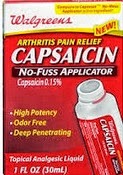
Capsaicin is an ingredient in many topical skin preparations used to relieve pain. Capsaicin is available as a cream, ointment, stick, pad, gel, liquid, or lotion. It is marketed under many brand names including Zostrix, Icy Hot Arthritis Therapy, Capsagel, and Arthricare for Women. Here, 10 things you should know about capsaicin:
1 - Capsaicin is the active component of chili peppers.
Capsaicin is actually an irritant to humans, producing a burning sensation in any tissue it touches. Capsaicin works by depleting or interfering with substance P, a chemical involved in transmitting pain impulses to the brain. The properties of capsaicin make it an option for relieving pain associated with osteoarthritis, rheumatoid arthritis, and diabetic neuropathy. Capsaicin is used to relievemuscle pain, joint pain, or nerve pain.
2 - Capsaicin is available over the counter.
You do not need a prescription for capsaicin from your doctor. You can find products containing capsaicin in your drugstore for over-the-counter purchase. You should follow the directions given by your doctor or the directions on the label (there are different dosages or strengths of capsaicin available). For pain relief, capsaicin is usually used 3 or 4 times a day. You should rub the capsaicin cream or gel into the painful area until no more cream is visible on the skin. Wash hands thoroughly after applying capsaicin to other areas of the body. If the capsaicin was applied for hand pain, however, wash your hands after 30 minutes.
3 - Don't use extra doses of capsaicin.
Stick to the directions, but if you should inadvertently miss a dose, use it as soon as you remember -- unless it's close to the time of the next dose.
4 - Capsaicin has no known drug interactions.
Though there are no recognized drug interactions with capsaicin, ask your doctor to be sure that you can use capsaicin, and continue to take your current medications. It's important to inform your doctor about any products you are using.
5 - Capsaicin may cause a burning sensation.
You will likely experience a warm, burning, stinging sensation when you begin using capsaicin. The sensation, which is expected when beginning use, may actually continue for 2 to 4 weeks. The sensation should lessen the longer you use capsaicin. Reducing the number of daily doses of capsaicin will not reduce the sensation, but it may reduce the pain relief achieved.
6 - Arthritis pain relief is not immediate.
Even with regular use of capsaicin, arthritis pain relief will take some time. Pain relief from arthritis typically is evident 1 to 2 weeks after starting capsaicin. To prevent pain from returning, capsaicin must be continued. However, if pain is not better after using capsaicin for 3 or 4 weeks, talk to your doctor. It may not be worth it to continue.
7 - Capsaicin must be handled with care.
Be aware of what can happen if you get capsaicin in your eyes or on other sensitive body parts because of the burning sensation it causes. If capsaicin gets in your eyes, immediately flush your eyes with water. To rid other sensitive areas of capsaicin and the burning feeling, wash the areas with warm soapy water. Keep capsaicin out of reach of children.
8 - Some people should not use capsaicin.
There are warnings about using capsaicin under certain circumstances. Before using capsaicin, tell your doctor about:
broken skin skin irritation previous allergic reactions to capsaicin, hot peppers, other drugs, dyes, foods, preservatives, breastfeeding, pregnancy or current attempts to become pregnant. Also, be aware that capsaicin should not be used by children under 2 years of age.
9 - Research supports use of capsaicin for osteoarthritis and rheumatoid arthritis.
A study from 1991 involved 70 osteoarthritis patients and 31 rheumatoid arthritis patients. Patients were instructed to apply 0.025% capsaicin or placebo to painful knees, four times a day. Results revealed that 80% of patients treated with capsaicin experienced pain reduction following two weeks of treatment.
10 - Research also supports the use of capsaicin for osteoarthritis of the hands.
That 10 things we should knows about capsaicin are listed above. Capsaicin recently are considered one of the product for global business. Thanks
ADAPTED FROM: thttp://osteoarthritis.about.com/od/painrelief/a/capsaicin.htm
By,
M Anem,
Senior Agronomist,
Precint 11, Putrajaya,
Malaysia.
(10 Dzulhijjah 1434H)








